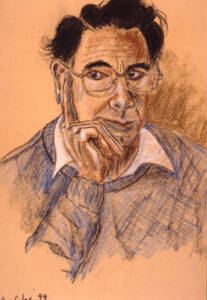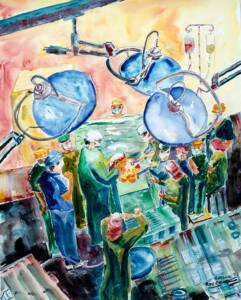
Calne self-portrait (1999) Courtesy of Sir Roy Calne
Roy Calne, whose role in developing liver transplantation brought about a revolution in organ transplantation, has passed away at the age of 93. Calne’s pioneering approach to transplantation medicine was recognized with a 2012 Lasker~DeBakey Clinical Medical Research Award, an award that he shared with his friend and colleague Thomas Starzl. “Through their systematic and relentless efforts,” the Award citation for Calne and Starzl stated, they “created a medical procedure that most physicians deemed an impossible dream.” For Calne, a surgeon by training, the dream began as a medical student in 1950 when he wondered why a young patient with severe kidney disease could not be saved by transplantation. The answer was rooted in the immune response—at the time, many of the basic discoveries concerning the immune system lay in the future. Early in Calne’s research career, he approached this problem by investigating compounds to counter organ rejection. Calne identified the first immunosuppressive drug to curb rejection and his team later helped introduce cyclosporine, which was much more effective.
In addition to his career in transplantation surgery and research, Calne was an avid and accomplished painter. His work often focused on portraying the warmth and humanity of his patients.

